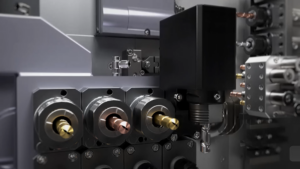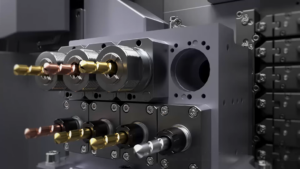In the CNC machining world, efficiency, precision, and productivity are key. The field is constantly evolving, introducing innovations such as quick-change tooling systems that are revolutionizing operations. This article aims to explore how these systems are transforming CNC machining by addressing its traditional challenges.

The Challenge of Traditional Tooling
Traditional machining, rooted in manual control, has been a mainstay in manufacturing for years. Yet, it faces notable limitations where precision and efficiency are critical. These include the labor-intensive nature of the process, potential variations in product quality from human error, and limited adaptability and versatility. In contrast, CNC machining, with its automated approach, offers significant improvements. However, it’s not without challenges, such as high initial costs, the need for skilled labor, difficulties in machining certain materials, design constraints, and ongoing maintenance and repair costs. Despite these hurdles, CNC machining remains essential in modern manufacturing, known for its unparalleled precision, speed, and efficiency. The advent of quick-change tooling systems is addressing many of these challenges, leading to more efficient manufacturing processes.
- High Initial Investment and Maintenance Costs: CNC machines represent a substantial financial investment, particularly challenging for smaller manufacturers. Additionally, the specialized software and regular maintenance required for these machines add to the operational costs.
- Skilled Labor Necessity: CNC machining demands a high level of expertise in programming and simulation. This requirement for skilled labor can be a barrier, especially when dealing with complex or unique designs.
- Machining Difficulties with Certain Materials: The physical properties of some materials make them difficult to machine, leading to increased tool wear and longer machining times.
- Design Constraints: CNC machining has its limitations in terms of the size, shape, and geometry of parts it can produce. Complex designs might require additional setups or tool changes, increasing production time and costs.
- Maintenance and Repair Costs: Regular maintenance is vital for CNC machines to ensure part quality and consistency. The wear and tear on tools can affect performance and precision, leading to additional costs for tool replacement and machine upkeep.
Despite these challenges, CNC machining remains a critical component in modern manufacturing, offering unparalleled precision, speed, and efficiency. The introduction of quick-change tooling systems addresses many of these issues, enhancing the capabilities of CNC machines and paving the way for more efficient manufacturing processes.
In the next section of the article, we will delve into the advantages of quick-change tools and how they are changing the CNC operations landscape, offering solutions to these traditional challenges.
Advantages of Quick-Change Tools in CNC Machining
Quick-change tooling systems significantly reduce machine downtime. Traditional tool changes in CNC machining, often requiring manual work, are time-consuming. These new systems streamline the process, allowing for quicker tool changes, leading to increased machine productivity. For instance, as reported by Modern Machine Shop, these systems can reduce setup time by up to 90% in certain scenarios, greatly boosting operational efficiency (Source: Modern Machine Shop).
The initial higher investment in quick-change tooling systems is offset by significant long-term cost savings. Reduced downtime not only enhances productivity but also cuts down labor costs linked to tool changes. Furthermore, the increased efficiency leads to less wear on tools and machines, lowering maintenance costs over time.
These systems also bring unmatched flexibility to CNC machining. They allow manufacturers to quickly adapt to different production needs, facilitating the handling of varied job orders, small batches, or custom work. This adaptability is vital in today’s varied and dynamic manufacturing landscape. A study published in the International Journal of Machine Tools and Manufacture underlines the importance of tooling flexibility in enhancing CNC machine adaptability (Source: International Journal of Machine Tools and Manufacture).
Lastly, quick-change tooling systems are designed for precision. They provide consistent tool positioning and repeatability, key in high-precision manufacturing. This helps maintain the quality of machined parts, reducing errors and the need for rework. An Engineering.com article discusses how these systems contribute to maintaining high precision in CNC machining.
Application of Quick-Change Tools in Tsugami Machines

Tsugami machines are well-regarded for their precision and reliability in CNC machining. Integrating quick-change tooling systems with these machines creates a powerful synergy, elevating their performance. These tools align perfectly with Tsugami’s high standards of precision, ensuring consistent quality and accuracy in production. This precision tool positioning complements Tsugami machines, making them even more suited for tasks requiring high precision.
The versatility of Tsugami machines is further enhanced with quick-change tooling. This addition allows for rapid tool changes and easy adjustments, enabling manufacturers to quickly switch between different production requirements. This adaptability is particularly beneficial in operations producing a variety of parts or requiring frequent tool changes, meeting the diverse and changing needs of modern manufacturing.
Furthermore, integrating quick-change tooling in Tsugami machines significantly increases production efficiency. Minimizing tool change times allows these machines to have less downtime, thus increasing output. This is crucial in high-volume manufacturing environments where time is a critical factor. The combination of Tsugami’s advanced machining capabilities with the efficiency of quick-change tooling systems results in an optimized production process that delivers both speed and quality.
Finally, the use of quick-change tooling in Tsugami machines can lead to significant cost savings over time. Despite a higher initial investment, the reduction in downtime, increased productivity, and lower labor costs contribute to a favorable return on investment. The durability and reduced maintenance requirements of both Tsugami machines and quick-change tools further reduce operational costs.
Long-term Benefits and ROI of Quick-Change Tooling in CNC Machining
Implementing quick-change tooling systems in CNC machining brings substantial long-term benefits and a strong return on investment (ROI). These systems significantly boost productivity by minimizing downtime. With swifter tool changes, machines operate more, leading to increased production rates. This is vital for high-volume manufacturing, where staying competitive is key.
Moreover, quick-change tooling systems ensure high product quality and consistency. Their precision and repeatability mean that each part is machined accurately, reducing defects and the need for rework. This consistency is especially important in sectors with strict quality standards.
In terms of costs, while the initial investment for quick-change tooling is higher, the long-term cost benefits are significant. Shorter tool change times translate to less manual labor, leading to labor cost savings. The extended lifespan of tools and reduced maintenance further contribute to lowering operational expenses.
Quick-change tooling systems also enhance flexibility and responsiveness to market changes. This ability to rapidly adjust production setups gives manufacturers a competitive edge in a constantly evolving market. Deloitte’s report on manufacturing flexibility emphasizes the importance of adaptable production systems in responding to market changes.
In conclusion, the long-term benefits and ROI from quick-change tooling in CNC machining are evident. These systems not only enhance productivity and product quality but also reduce costs and offer flexibility, making them a compelling choice for manufacturers aiming to optimize their operations and stay competitive.
Conclusion: Embracing Quick Change Tooling for Future CNC Machining Success
As we wrap up our exploration of quick-change tooling in CNC machining, it’s evident that these systems mark a significant advancement in manufacturing technology. They not only address the traditional challenges of CNC operations but also set the stage for more efficient, adaptable, and cost-effective manufacturing processes.
Looking towards the future, the integration of quick-change tooling is a critical step in the evolution of CNC machining. With ongoing technological advancements and increasing demands for high-quality, precision-manufactured parts, the ability to rapidly adapt and respond to market needs is vital. Quick-change tooling systems are at the forefront of this shift, offering agility and efficiency essential for staying competitive.
National Machine Products stands committed to leading the way in this technological advancement within CNC machining. Our range of lathe tool holders exemplifies our dedication to precision and efficiency. By offering cutting-edge solutions like quick-change tooling, we empower manufacturers to elevate their operations, reduce costs, and improve the quality of their output. We invite you to explore our diverse range of tool holders and learn more about how they can transform your manufacturing processes at National Machine Products – Lathe Tool Holding.
In summary, the journey towards optimized CNC machining is ongoing, and quick-change tooling systems are a significant milestone in this journey. As the industry evolves, adopting these advancements will be crucial for success. For manufacturers, investing in quick-change tooling is not merely an upgrade in equipment; it represents an investment in the future of manufacturing.
